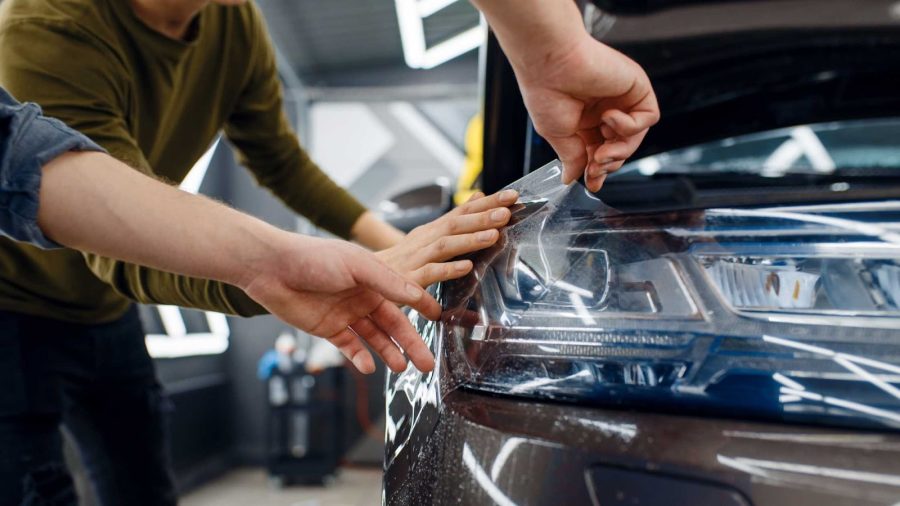Owning a car is a significant investment, and maintaining its pristine appearance is a priority for many car enthusiasts. Unfortunately, daily driving exposes vehicles to a variety of hazards, from rock chips and scratches to UV damage and environmental pollutants. For those looking to keep their cars looking like new, Paint Protection Film (PPF) is the ultimate solution.
Paint Protection Film, also known as clear bra, is a transparent, ultra-durable film applied to a vehicle’s painted surfaces to shield it from damage. In this blog, we’ll delve into the benefits of PPF, how it works, and why it’s essential for any car owner looking to protect their investment.
What is Paint Protection Film (PPF)?
Paint Protection Film (PPF) is a clear, flexible thermoplastic urethane film designed to protect a vehicle’s paint from damage. Originally developed by the military to protect helicopter blades, PPF has since evolved into a popular solution for automotive protection. It is applied to the exterior surfaces of the car, including the hood, fenders, mirrors, and bumpers, providing a virtually invisible layer of protection.
PPF is highly durable, with a lifespan of up to 10 years, depending on the brand and quality. Its self-healing properties allow it to absorb minor scratches and swirl marks, making them disappear with exposure to heat. This unique feature ensures that your vehicle’s paint remains flawless over time.
The Benefits of Paint Protection Film
PPF offers several advantages that make it a must-have for car owners who want to preserve their vehicle’s appearance and value.
-
Superior Protection:
The primary benefit of PPF is its ability to protect your vehicle’s paint from a wide range of hazards. Whether it’s small stones kicked up by the tires, road debris, or even bird droppings, PPF provides a robust barrier that prevents damage to the paint.
PPF is also highly resistant to UV rays, which can cause paint to fade and deteriorate over time. By blocking UV rays, PPF helps maintain your car’s factory-fresh appearance for longer.
-
Self-Healing Technology:
One of the most impressive features of modern PPF is its self-healing capabilities. Minor scratches, swirl marks, and scuffs that occur during everyday driving are absorbed by the film and disappear when exposed to heat, such as sunlight or warm water.
This self-healing property keeps your car looking flawless and eliminates the need for frequent polishing or touch-up paint jobs.
-
Stain and Chemical Resistance:
PPF is highly resistant to stains, making it an excellent defense against things like bird droppings, tree sap, road salt, and other contaminants that can damage your car’s paint. The film’s hydrophobic properties also make it easier to clean, as water and dirt are less likely to adhere to the surface.
-
Preserves Resale Value:
A car with well-maintained paint is worth more when it comes time to sell or trade it in. By protecting your car’s paint from damage, PPF helps preserve its value, ensuring that your investment holds up over time.
-
Virtually Invisible Protection:
One of the best things about PPF is that it’s almost invisible once applied. It provides a high-gloss, clear finish that enhances the appearance of your vehicle without altering its original color or design. For those who want maximum protection without sacrificing style, PPF is the perfect solution.
The Installation Process: What to Expect
Installing PPF requires precision and expertise to achieve a seamless finish. The process typically involves the following steps:
- Preparation: The vehicle’s exterior is thoroughly cleaned and any imperfections in the paint are corrected. This ensures that the PPF adheres smoothly and that the finish is flawless.
- Application: The PPF is carefully applied to the vehicle’s surface, with each piece custom-cut to fit specific areas of the car. The film is stretched and smoothed to remove any bubbles or wrinkles.
- Finishing Touches: Once the film is in place, the installer will inspect the application for any imperfections and make adjustments as needed. The edges of the film are tucked neatly, and any excess material is trimmed.
After installation, it’s essential to allow the film to cure properly. This process can take up to 48 hours, during which the vehicle should be kept in a controlled environment and away from moisture.
PPF vs. Ceramic Coating: Which is Right for You?
While both PPF and ceramic coatings offer excellent protection for your vehicle, they serve different purposes. PPF is primarily designed to protect against physical damage, such as rock chips and scratches, while ceramic coatings provide a hydrophobic, chemical-resistant layer that enhances shine and makes the car easier to clean.
For those looking for maximum protection, combining PPF with a ceramic coating can provide the best of both worlds. The PPF protects against physical damage, while the ceramic coating enhances the film’s hydrophobic properties and adds an extra layer of protection against environmental contaminants.
Conclusion: Protect Your Investment with PPF
Paint Protection Film is a game-changer for car owners who want to keep their vehicles looking brand new. Its superior protection, self-healing technology, and virtually invisible finish make it the ideal choice for anyone who values their car’s appearance and wants to maintain its value.
If you’re ready to safeguard your vehicle with the ultimate protection, contact us today to learn more about our professional PPF installation services.

